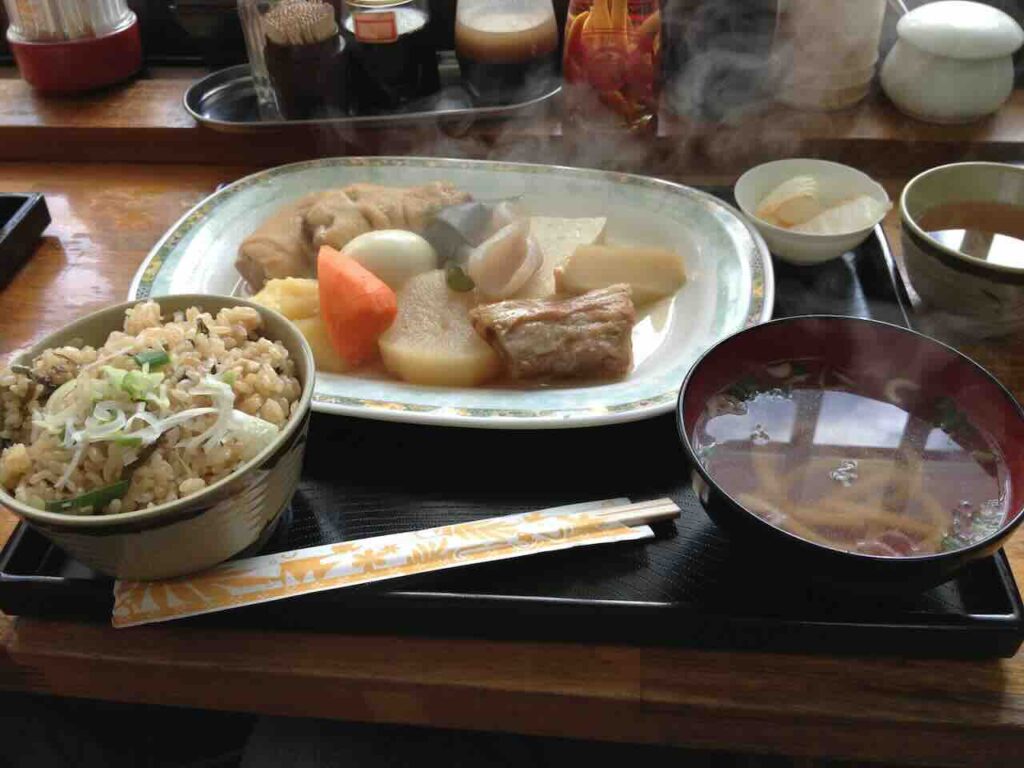When people think of Okinawan cuisine, dishes like Goya Champuru, Taco Rice, or Soki Soba often come to mind. But nestled quietly in the island’s rich culinary landscape is a local variation of one of Japan’s most beloved comfort foods: Okinawan Oden.
While oden is enjoyed throughout Japan as a classic winter dish, Okinawa’s version brings its own distinct flavors, ingredients, and cultural nuances — making it a must-try for anyone eager to explore the hidden gems of regional Japanese food culture.
What Makes Okinawan Oden Unique?
A Distinctive Broth: Pork Meets Bonito
The foundation of any good oden is its broth, and Okinawan Oden sets itself apart right from the start:
- The broth typically combines bonito (katsuobushi) with pork ribs (sōki).
- This blend creates a deeply savory, umami-rich, and slightly fatty flavor, contrasting with the lighter soy-based broths of mainland Japan.
- The infusion of pork reflects Okinawa’s unique culinary identity, shaped by its Ryukyuan heritage, tropical climate, and historical influences.
The Sweet and Spicy Island Sauce
Unlike most mainland oden, which is simply enjoyed straight from the broth, Okinawan Oden is often accompanied by:
- A sweet and spicy dipping sauce, made from soy sauce, sugar, and local island chili peppers (shima tōgarashi).
- This sauce provides a subtle heat and sweetness that perfectly complements the richness of the ingredients.
Year-Round Comfort Food
- While oden is traditionally seen as a winter dish in mainland Japan, Okinawan Oden is often enjoyed year-round, thanks to the island’s subtropical climate and unique dining customs.
The Star Ingredients of Okinawan Oden
Tebichi (Pig’s Feet)
- One of the most iconic ingredients in Okinawan Oden.
- Simmered slowly until gelatinous and tender, pig’s feet provide a silky mouthfeel from the rich collagen content.
- A beloved ingredient reflecting Okinawa’s long tradition of nose-to-tail cooking.
Sōki (Pork Ribs)
- Meaty, fall-off-the-bone pork ribs that add deep flavor to both the broth and the eating experience.
- Sōki is also featured in many other Okinawan dishes, such as Sōki Soba, but takes on a slightly different personality when slow-simmered in oden broth.
Kombu-maki (Kelp Rolls)
- Pork pieces wrapped in kombu (kelp) and secured with thin strings.
- The seaweed’s natural umami beautifully balances the pork’s richness, while also tying back to Okinawa’s maritime food culture.
Yushi-dōfu (Fresh Okinawan Tofu)
- A softly set, delicate tofu unique to Okinawa, typically served warm and unpressed.
- Its creamy, custard-like texture absorbs the flavors of the broth while remaining refreshingly light.
Other Common Ingredients
- Jimami-dōfu (Peanut Tofu): A distinctly Okinawan tofu made from peanuts rather than soybeans.
- Satsuma-age (Deep-Fried Fish Cake): Adds sweetness and texture.
- Daikon (Radish), Konnyaku, and Eggs: Also commonly found, bridging the familiar with the regional.
How to Eat Okinawan Oden Like a Local
- Crack a soft-boiled egg directly into the steaming hotpot — the creamy yolk enriches the broth and blends with the other flavors.
- After finishing the main ingredients, many locals will pour the remaining broth over a bowl of rice to create Jūshī-style comfort food, maximizing every drop of the flavorful broth.
- Don’t forget to dip individual items into the sweet-spicy island sauce for the full Okinawan experience.
The Cultural Significance of Okinawan Oden
Okinawan Oden is not just a regional adaptation — it reflects Okinawa’s distinct food philosophy:
- The island’s subtropical environment and historical trading ties introduced both pork and a wide variety of local ingredients.
- The emphasis on using the whole animal speaks to the region’s resourcefulness and deep-rooted respect for food.
- Like much of Okinawan cuisine, the dish subtly reflects the island’s independent Ryukyuan cultural identity while still existing within broader Japanese culinary traditions.
Summary
Okinawan Oden offers a fascinating twist on Japan’s classic hotpot tradition. With its rich pork-and-bonito broth, specialty ingredients like tebichi and yushi-dōfu, and its unique sweet-spicy dipping sauce, it’s a dish that embodies the flavors, creativity, and resilience of Okinawan food culture.
The next time you visit Okinawa, be sure to seek out a local oden stand — often found at izakayas, street stalls, or casual eateries. It’s a flavorful journey into an often-overlooked corner of Japan’s culinary diversity that your taste buds won’t soon forget.


